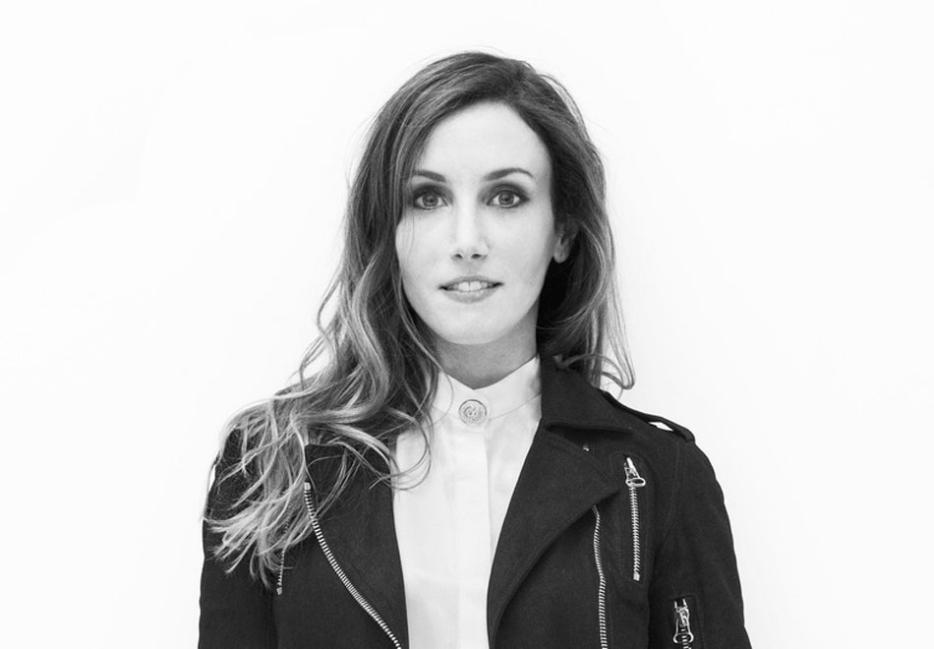Marisha Pessl followed Woody Allen down Park Avenue, an act she rationalizes with the slightly abashed pride of a kid who just ate something really weird. She wasn’t stalking him, she explains—he just happened to be in front of her. They were going in the same direction anyway.
Pessl is skilled at covertness. This is a writer who churned out her first novel [2006’s Special Topics in Calamity Physics] while seeming legitimately busy in a cubicle at PricewaterhouseCoopers, hiding her growing text in the cells of an Excel spreadsheet.
Currently living in Manhattan, Pessl is no longer obliged to conceal her fiction under the auspices of financial consulting and/or supply chain management. But she still loves secrets, and her new thriller, Night Film, is a 600-page ode to the shadiest of them.
Ensconced in the amber confines of the Hazlitt recording studio—circular, cross-hatched mics blocking our mouths—Pessl talks about the just-released book, which tracks an investigative journalist named Scott McGrath as he pursues a mysterious filmmaker, Stanislas Cordova, by way of Cordova’s recently deceased daughter, Ashley. Husky of voice and shrewd as hell, Pessl discusses the sprawling Night Film with the intensity of recreational sleuth—a reflection of her willingness to stalk an idea to its heart, and a director to his (sometimes literal) front door.
Next time I’m in NY I’m going to keep my eyes peeled for Woody.
You will see him. I have followed him [LAUGHS]. It’s all coming out now. I actually have followed him because he has his editing facility really close to my apartment. I followed him down Park Avenue.
You’re a big fan of his, I hear. Well, clearly.
I am. To the point of becoming a little teary-eyed—people walking by were like, “That was Woody Allen!” It kept happening again and again, this domino effect. He wears this little fisherman’s cap. He’s so cool. I mean, he has his issues, but I love his movies.
Do you have any favourites?
I love his heyday, like the Manhattan, Annie Hall years, and then up to Hannah and Her Sisters. But I also love The Curse of Jade Scorpion—the movies that no one can stand. Even a “bad” Woody Allen film, there’s something to think about. There’s some idea or interesting premise that’s worth a discussion.
Speaking of a somewhat enigmatic and well-loved director—this seems like a fitting place to start talking about Night Film. Central to the novel is an absent figure, a filmmaker by the name of Stanislas Cordova. Can you tell me a bit about the mythology of Cordova?
I started by researching a lot of different filmmakers, especially auteur theory—people willingly giving their lives over to a man in order to make a film, to make art. Certainly I was inspired by Woody Allen and David Lynch, but especially Stanley Kubrick. Someone who was written about ceaselessly—called an egocentric, an egomaniac, and an eccentric. Rumours were constantly swirling about him, but when you actually look behind the curtain, he was known to be an incredibly warm and funny person, beloved by his family. So certainly that premise of where the myth intersects with the human—the man—that was a starting point for Cordova.
Cordova is known for making these horrifying “night films” from which the book gets its title. Did you coin that term, or was it something that existed previously?
I coined it, but I’ve since read some 1960s review about really obscure French films that were called night films—so it does turn up in obscure film theory. Especially talking about film noir, and really dark films where there’s not a lot of light, physically, on the film.
What attracted you to those genres? Noir, horror. Did you ever think about making him a different kind of filmmaker, or was that choice absolute?
I was entranced by the idea of a patriarch and an artist who brings people into his orbit. But in terms of the mood and the noir, modern Gothic tone that Night Film has, I started from my own desire as a reader. Late 2008 was in a very tumultuous time in the world, and I wanted a book that was a dark odyssey—something with really strong forward movement, entertaining, but multi-layered. It was my own desire for such a book. I think a lot of writers have that same impetus: they write what they would like to read.
The odyssey, as you called it, is a pursuit by investigative reporter named Scott McGrath. I found that so interesting, your selecting this protagonist to be a writer, and not, say, a PI or a cop. He seems like a very real writer—he investigates the ivory trade, he wrote a book called Cocaine Nation—
Cocaine Carnivals, actually! Cocaine Nation sounds good, too.
Oh my gosh, it’s an Elizabeth Wurtzel B-side.
Coming off of my first novel [Special Topics in Calamity Physics], where the main character was this very bookish adolescent, I wanted a streamlined voice. A very rational person with a lot of life experience; experience going after a very dark or hidden truth. Then I could have that level of expertise when he sets off to investigate the death of this young woman, whose father is, of course, Stanislas Cordova. It was also a way for me to grow as a writer. Having gotten over that need to write the coming-of-age novel, I really wanted to delve into something much darker—where there are fewer places to hide in the narrative.
The mythology is so carefully invented—it’s so immersive, Cordova’s mystery. But then you also probe at it by way of Scott, who’s skeptical even as things become more and more alien. You capture this conflicted feeling of being intrigued by lore while also wanting to dissemble it.
Every time I fall in love with a film or a book, I have a ravenous need to find out whom the creator is. But when I’m the creator, I don’t want anyone to know about myself and it’s that constant tension of how much to reveal, because in the end, even in the social media age, I’m not really comfortable revealing very much. I did a lot of research on Picasso, who had this insatiable vampirism, in a way. He could be up for days talking to people—people would die to hang out with him. But following spending time with him, they would be absolutely exhausted, sucked dry. And then he would go off and paint for days at a time, in this wild heat of energy. In a way, I understand it. In my 20s, I had a voracious need to write all night. Now I’m much more practical. Now I actually want to be one with the world and not so extreme.
There’s a part in the book where Cordova’s longtime assistant, Inez Gallo, mentions that the obscurity surrounding his life is important, both for his work and also to maintain the tension between his films and audience. Does this reflect a yearning you have for a time before social media, before this period of transparency?
That statement that Inez Gallo makes about the artist needing a dark private space—I absolutely believe that. I think the onus is on artists today to find that private space where you can create and make mistakes. You have to find those shadows where no one happens to be watching, because then you have total freedom to explore. In terms of social media, I have accepted it and I can now see the benefits of connecting and discussion and being able to hash something over. But of course, it’s walking a fine line. When we interact online, identity is very upfront, when in fact the human mind is so much more complex than social media will allow. Cordova is the antithesis of what we have in popular culture, where people want to be seen, want to be commented on. I like the idea of someone who creates work that you have to dig for—someone who isn’t selling something.
Do you have a history with horror? Are you a horror lover?
I’m a terror lover. Terror is fear and anxiety over what is not seen, and horror is revulsion and fear over what you have just seen. I like terror movies really, psychological terror where the characters are fumbling in the dark, totally unaware of what they’re stumbling towards. Thrillers in the vein of Repulsion, or Knife in the Water, or Rosemary’s Baby. Occasionally I will like a flat-out horror movie—I do like a few of those 1970s crazy horrors, but there’s a level of camp that isn’t scary to me. It’s much more compelling and gutting to not know what you’re stumbling toward, but you still have to find out. Which is what Night Film really is about.
It does produce genuine fear. There was a sequence maybe two-thirds of the way through the book [QUASI-SPOILER ALERT] at The Peak where I was scared out of my wits. I texted a friend who was also reading it to express how freaked out I was.
Coming off of Special Topics, the most amazing feedback I had from readers was not about the language and the references and or even the characters, but the moment in the woods when Blue was isolated. They’d say, “That was the moment I was absolutely terrified by.” So I took that and started to think—is it even possible in this day and age to be scared anymore? There’s a level of cynicism now, a sense of, “Oh we’ve seen that, it’s a special effect.” Certainly that was something of a challenge, and I wanted readers to have a sense of anxiety and dislocation and fear. Fear is the ability to engage with the present, and as Cordova’s philosophy states, when you’re in the present, that’s when you truly begin to live. His gateway is fear.
There’s a point in the novel where his philosophy is partially compounded into the line, “Freak the Ferocious Out.” A philosophy, like you said, of fear and what it does. How is fear a gateway, and how does Scott access it?
To watch one of Cordova’s films is the beginning of freedom. Freedom for Cordova means an ability to design your own life from scratch, building a life, rather than living it as an automaton based on what society dictates. Through allowing people to be terrified [by the films], it just starts to pull them out of a numbness that Cordova has identified within society.
Night Film is really, really densely plotted—how did you keep track of the chronology and the character details? The timing seems so delicate.
In contrast to Special Topics, I did not want to rationally plot Night Film. I wanted whatever truth the characters end up finding to come organically from the narrative—to not stage-manage too much. The answers I ended up coming to plot-wise were indigenous to the story and the landscape I’d already set up. I liked that writing process much better, even though it was more terrifying because I often didn’t know where I was going. I always have sort of a bible, which is in the form of a Moleskine notebook, and I tear out photographs and articles and anything that will start building the mood of the novel. I think of things very visually as a writer—I want to know what things look like.
Seems natural then, the visual elements to the novel—like the New York Times articles, the photos on the Blackboards [a secret Cordova fan site], the doctor’s reports.
It was always part of Night Film. I think when I first wrote the proposal and showed it to my agent, it was in the form of this scrapbook. Case notes from Scott McGrath for the biography that he was writing about Cordova—this archive hinting at the world of the novel. I am a huge fan of estate sales and antique shops and anything presenting the ephemera that people leave behind. I witnessed this in my own way when my grandmother passed away, and she was in assisted living for the last few months of her life, and when my mom and I had to go into her room and clean out all of her things and her photographs and each piece had such a powerful hold on me, but hinting at what her life was.
That impulse also relates to a riskier component of the book’s design—the interactive elements, which I only discovered when I got to the end.
Oh good. When we were talking about all these extra elements, I was very adamant that I wanted people to be able to read the novel straight through and not be interrupted with any kind of technology. And then, if people want to continue the experience, then you can download the app [the Night Film Decoder]; then you can Google “Cordova” and discover some “found footage” that I wrote and produced with this great production company. They’re really just supplemental roads that allow the storytelling experience to be 360 degrees—which is where storytelling is in this day and age. However, the novel is the centrepiece.
Were you at all concerned that by introducing this extra media at the end of the book, that might somehow corrupt the imaginative work that the reader had already done?
All the accompanying material concerns peripheral characters inside stories. So none of those main characters are compromised. Because I agree, I want 90 per cent of it to live within the reader’s imagination—the other 10 per cent being the visuals. For example, there’s a scene within the book where this washed-up movie star has one line talking about the fate of a very obscure actress named Lulu Swallow who was in one of Cordova’s films—that’s all that’s stated. She’s mentioned twice within the book, but when you download the app, you are actually able to peruse Lulu Swallow’s lost personal diary that was found outside of The Peak. And so that gives a beginning, middle, and end to her story. Of course it’s a peripheral story and not the heart of Night Film, which is only found within the book.





